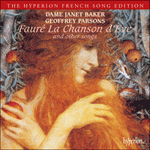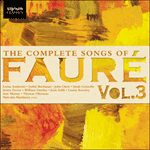Here we must compare Fauré with Debussy. That composer’s song, the second of the
Ariettes oubliées, is entitled ‘Il pleure dans mon cœur’ and was first published in 1888. There is no sign of Fauré being influenced by the younger man’s music which is still under the spell of Massenet, its wide-ranging vocal lines and sumptuous, swooning harmonies engineered to delight, rather than disturb, the listener. If Debussy’s music here suggests the hot-house of the ‘décadence’, Fauré goes for a darker and altogether more intense verismo mood. The songs of 1888 (the others are
Au cimetière and
Larmes) are
cris du cœur, definitely not pastels. Both composers effectively evoke the falling of rain on the miserable lodgings that Verlaine shared with Rimbaud in Camden Town, north London, in the autumn of 1872. Debussy’s oscillations in thirds suggest a monotone drizzle; Fauré’s staccato semiquavers alternate closely between the hands. This pattering motif sometimes giving way to churning triplets, Fauré’s whole construction is undeniably tighter, more of a piece, than Debussy’s. The latter’s ‘Quoi! nulle trahison?’ is set as a recitative; with Fauré this desperate exclamation is kept within the song’s ongoing momentum, and sounds more frightened than lethargic. The diminuendo, as well as the freezing of the harmonic movement in the piano-writing after ‘Sans amour et sans haine’, speaks volumes. ‘Mon cœur a tant de peine’ is set to a downward scale, drained of its confidence; we can imagine the poet turning his face to the wall. The seven-bar postlude is undemonstrative in the manner of the depressed who are rendered helpless as they sink into the depths of despond.
from notes by Graham Johnson © 2005
Ici, il nous faut comparer Fauré et Debussy, dont la mélodie «Il pleure dans mon cœur» – en fait, la deuxième des
Ariettes oubliées – parut pour la première fois en 1888. Rien ne dit que Fauré fut influencé par la musique de ce cadet resté sous le charme de Massenet, de ses amples lignes vocales, de ses somptueuses et langoureuses harmonies troussées pour ravir l’auditeur plus que pour le déranger. Autant la musique de Debussy évoque le foyer de la décadence, autant Fauré s’embarque dans une atmosphère d’un verismo plus sombre et autrement plus intense. Or, les mélodies de 1888 (les deux autres étant
Au cimetière et
Larmes) sont des cris du cœur, tout sauf falots. Les deux compositeurs suggèrent avec efficacité la pluie qui tombe sur le misérable meublé de Verlaine et Rimbaud, à Camden Town, dans le nord de Londres, à l’automne de 1872. Les oscillations en tierces debussystes induisent un crachin monotone, tandis que les doubles croches staccato fauréennes alternent étroitement entre les mains, en un motif crépitant qui cède parfois la place à de bouillonnants triolets – d’où une construction indéniablement plus resserrée, plus monobloc. Mise en musique sous forme de récitatif chez Debussy, l’exclamation désespérée «Quoi! Nulle trahison?» est maintenue par Fauré au sein de l’élan d’ensemble et paraît plus apeurée que léthargique. Le diminuendo en dit long, de même que le gel du mouvement harmonique dans l’écriture pianistique après «Sans amour et sans haine». «Mon cœur a tant de peine» est mis en musique sur une gamme descendante, vidé de sa confiance – on imagine le poète, le visage face au mur. Le postlude de sept mesures est peu démonstratif, comme le sont les déprimés, impuissants car abîmés dans les tréfonds de l’abattement.
extrait des notes rédigées par Graham Johnson © 2005
Français: Hypérion


 Fauré: La chanson d'Ève & other songs
Fauré: La chanson d'Ève & other songs Fauré: The Complete Songs, Vol. 3
Fauré: The Complete Songs, Vol. 3
